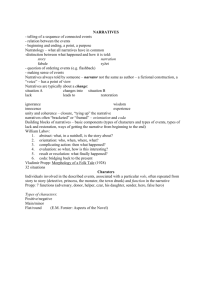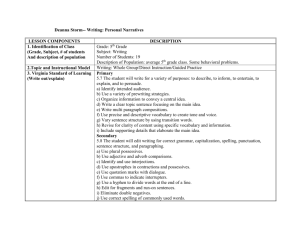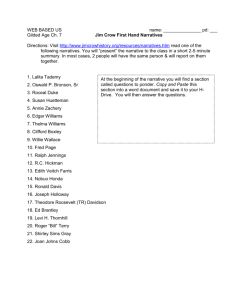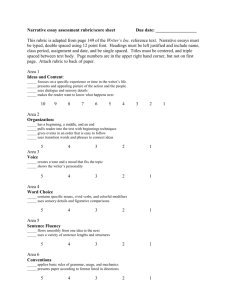Writing plans for week of nov 26 - fourthgradeteam2012-2013
advertisement
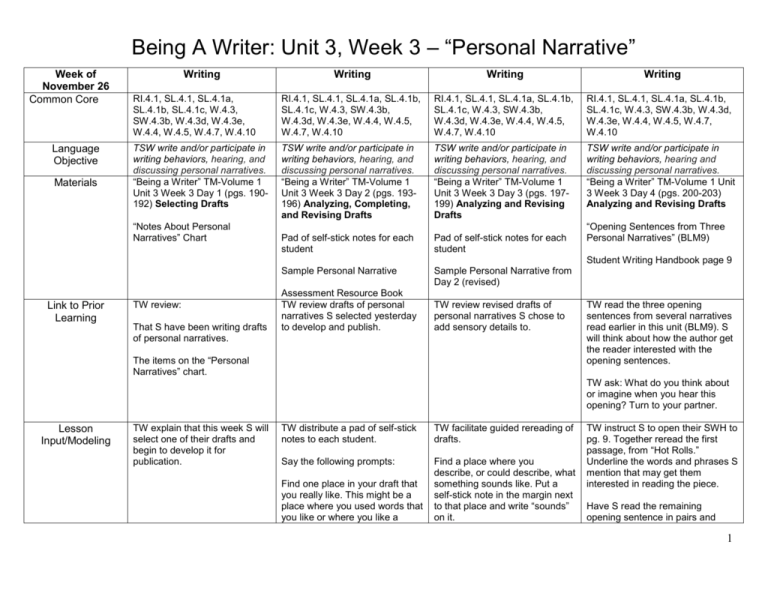
Being A Writer: Unit 3, Week 3 – “Personal Narrative” Week of November 26 Common Core Language Objective Materials Writing Writing Writing RI.4.1, SL.4.1, SL.4.1a, SL.4.1b, SL.4.1c, W.4.3, SW.4.3b, W.4.3d, W.4.3e, W.4.4, W.4.5, W.4.7, W.4.10 RI.4.1, SL.4.1, SL.4.1a, SL.4.1b, SL.4.1c, W.4.3, SW.4.3b, W.4.3d, W.4.3e, W.4.4, W.4.5, W.4.7, W.4.10 RI.4.1, SL.4.1, SL.4.1a, SL.4.1b, SL.4.1c, W.4.3, SW.4.3b, W.4.3d, W.4.3e, W.4.4, W.4.5, W.4.7, W.4.10 RI.4.1, SL.4.1, SL.4.1a, SL.4.1b, SL.4.1c, W.4.3, SW.4.3b, W.4.3d, W.4.3e, W.4.4, W.4.5, W.4.7, W.4.10 TSW write and/or participate in writing behaviors, hearing, and discussing personal narratives. “Being a Writer” TM-Volume 1 Unit 3 Week 3 Day 1 (pgs. 190192) Selecting Drafts TSW write and/or participate in writing behaviors, hearing, and discussing personal narratives. “Being a Writer” TM-Volume 1 Unit 3 Week 3 Day 2 (pgs. 193196) Analyzing, Completing, and Revising Drafts TSW write and/or participate in writing behaviors, hearing, and discussing personal narratives. “Being a Writer” TM-Volume 1 Unit 3 Week 3 Day 3 (pgs. 197199) Analyzing and Revising Drafts TSW write and/or participate in writing behaviors, hearing and discussing personal narratives. “Being a Writer” TM-Volume 1 Unit 3 Week 3 Day 4 (pgs. 200-203) Analyzing and Revising Drafts Pad of self-stick notes for each student Pad of self-stick notes for each student Sample Personal Narrative Sample Personal Narrative from Day 2 (revised) “Notes About Personal Narratives” Chart Writing “Opening Sentences from Three Personal Narratives” (BLM9) Student Writing Handbook page 9 Link to Prior Learning TW review: That S have been writing drafts of personal narratives. Assessment Resource Book TW review drafts of personal narratives S selected yesterday to develop and publish. TW review revised drafts of personal narratives S chose to add sensory details to. The items on the “Personal Narratives” chart. TW read the three opening sentences from several narratives read earlier in this unit (BLM9). S will think about how the author get the reader interested with the opening sentences. TW ask: What do you think about or imagine when you hear this opening? Turn to your partner. Lesson Input/Modeling TW explain that this week S will select one of their drafts and begin to develop it for publication. TW distribute a pad of self-stick notes to each student. TW facilitate guided rereading of drafts. Say the following prompts: Find a place where you describe, or could describe, what something sounds like. Put a self-stick note in the margin next to that place and write “sounds” on it. Find one place in your draft that you really like. This might be a place where you used words that you like or where you like a TW instruct S to open their SWH to pg. 9. Together reread the first passage, from “Hot Rolls.” Underline the words and phrases S mention that may get them interested in reading the piece. Have S read the remaining opening sentence in pairs and 1 Being A Writer: Unit 3, Week 3 – “Personal Narrative” sentence you wrote. Put a selfstick note in the margin next to that place and write: “I like” on it. Find a place in your dragt where you describe, or could describe, what something looks like. Put a self-stck note in the margin next to it and write “looks” on it. Key Question(s) Guided Practice What have you learned about personal narrative, compared to other kinds of writing? TW explain to S that they will reread all the personal narrative drafts they have written so far. They will select a draft they can imagine making changes to. What sensory details might you add to help the reader imagine what’s happening? TW model step 2, page 194: “Model Developing a Marked Section of the Draft” Find a place where you describe what something feels like. Put a self-stick note in the margin and write “feels like” on it. Find a place where you describe, or could describe, how something smells or tastes. Put a self-stick note in the margin and write “smells” or “tastes” on it. What words could you add to help your reader [see/hear/smell/taste/feel] what’s happening? TW model adding the following sensory details to the sample writing from yesterday: “sounds”, “smells”, or “tastes”. Display the writing sample you will revise on the board. Ask: As you’re looking through your drafts, what might you want to look for to help you decide which one to develop? Independent Practice TS will: 1. Select a draft to develop and publish. TW circulate and ask the following of individuals: Why did you choose this piece to revise? underline the words and phrases they feel are effective at making the reader want to read more. What does the author do to get us interested in reading this piece? What words or phrases help us imagine what’s happening? TW ask S to reread the first few sentences of their own personal narratives. Ask and have the students think to themselves about: How might you revise your opening sentences to “hook” the reader and make him or her want to keep reading? TSW write silently for 20-30 minutes. TSW write silently for 20-30 minutes. TSW write silently for 20-30 minutes. Complete your draft. Add more sensory details to help the reader imagine what’s happening. Revise your opening sentences so they “hook” your reader. Add sensory details to places you marked to help the reader imagine what’s happening. Remove self-stick notes when you finish adding details. Remove self-stick notes when you finish adding details. Make any other revisions or additions so your piece is complete and as interesting as it can be. Add to your story until it is TW begin conferring with individual 2 Being A Writer: Unit 3, Week 3 – “Personal Narrative” What can you imagine adding or changing in this piece to make it more interesting? 2. Confer in pairs about selected drafts. Why did your partner select that draft? finished. TW join the students in writing for a few minutes; then walk around the classroom and observe. students about the piece they are developing for publication. TW circulate and individuals who may be having difficulty adding to their drafts. Document observations in the Assessment Resource Book. What’s interesting to you about your partner’s draft? What else did your partner tell you about the draft he is going to work on to publish? Summary/Closure Sharing and Reflecting Sharing and Reflecting Sharing and Reflecting TW ask and briefly discuss: TW ask and briefly discuss: TW ask and briefly discuss: What did you do today to make sure you could accurately share what your partner said with the class? What sensory details did you add to your draft? Read us that part. What did you imagine as you listened to the revisions? Why is it important that each of us take responsibility for listening carefully to your partner? What did you imagine when you heard the sensory details? How are the revisions different from the original? What questions can we ask? What did you do to take responsibility for your own work during writing time today? How does that help to build our community? Sharing and Reflecting TW ask and briefly discuss the following: What words did you hear in the opening sentences that make you want to keep reading? What ideas, if any, does this give you for your own opening sentences? How did you do today giving your full attention to the people who were sharing their writing? If you weren’t giving your full attention today, what will help you give your full attention the next time we have a class discussion? 3 Being A Writer: Unit 3, Week 3 – “Personal Narrative” Differentiation Read aloud. S partners, graphic organizers for struggling scholars. Read aloud. S partners, graphic organizers for struggling scholars. Read aloud. S partners, graphic organizers for struggling scholars. Read aloud. S partners, graphic organizers for struggling scholars. 4



